|
Aurora Gallery back to spaceweather.com |
| Summary: A coronal mass ejection hit Earth's magnetic field on May 15th, sparking an extreme geomagnetic storm. [See also the April 2005 aurora gallery.] Page 1 | Page 2 | Page 3 | Page 4 | Page 5 | This is Page 6 | Page 7 | Page 8 Got
pictures? Submit
them. |
| Photographer, Location | Images | Comments | |
|
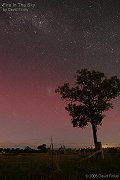
|
David Finlay,
Wilton, NSW, Australia May. 15 |
#1 |
There was no detail to last night's aurora; no columns or rays of gently moving light as we have seen before. Just a very large mass of red and purple glowing light. I've never seen it that high before. It was at times at least 60 degrees above the horizon. For all you northern hemisphere people, it is very rare to see aurora from 34.4 degrees south. I drove out to Wilton into the only patch of clear sky I could see, and stayed out there until 10pm when it started to RAIN! |
|
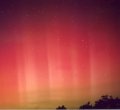
|
Pierre
St. Hilaire, San Jose, California, USA May. 15 |
#1, #2 |
These pictures were taken halfway between San Jose, CA, and Lick Observatory. At its peak, the aurora covered most of the Northern sky, all the way to the zenith. It was very dynamic and colorful, a real treat from this far south. 15 sec. exposure on Fuji Superia 800, Olympus OM-1 with a 50 mm lens at f/1.4 . |
|
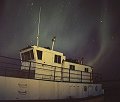
|
Mark Golub,
Gull Harbor on the the tip of Hecla Island, Manitoba, Canada. May. 15 |
#1, #2, #3, more | The Aurora danced all night through dawn. What a show! All shots taken with Provia 100F pushed 2 stops on a Pentax Spotmatic w/ 28mm lens. Shot at f/2. Thank you spaceweather.com for your great predictions! |
|

|
Dean W. Armstrong,
Yerkes Observatory, Williams Bay, Wisconsin May. 15 |
#1, #2, #3, #4, more |
A green display appeared to the north and grew in intensity until it was overhead and further south. After an hour or so it suddenly changed into pastel blue, violet, and lavender and continued a strong display until dawn. The images were taken with a Canon A95 digital camera, with exposures ranging from 5 to 15 seconds, ASA 100 to 400. |
|
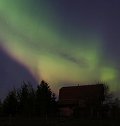
|
Peter Boytang,
Near Edmonton, Alberta. May. 15 |
#1, more |
Canon EOS 10D 15 second exposure ISO 200 with a 28mm lens set to f/3.5 |
|
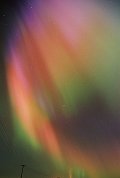
|
Robert B Slobins,
La Otto, Indiana, USA May. 15 |
#1, #2, #3, #4 |
One of the biggest, brightest, and most active displays I ever observed, and to think that this was a product of a trifling M8 solar flare. At the time of these images, 0800-0830Z, up to 3/4 of the sky was covered at times. Within this timeframe, however, the aurora had cleared so that Ursa Major and Scorpius and Sagittarius were the only major constellations clearly visible with a wide band of aurora overhead. Details: Canon F1n, Canon 24/1.4L lens, Fujicolor NPH film (ISO 400) exposures c. 20 seconds at f/2. |
|

|
John Owens,
Milwaukee, Wisconsin, USA May. 15 |
#1, #2, #3, #4, more |
As I was walking home, I was looking at Arcturus, and annoyed by that 'bright cloud' near it. Turned north, and realized that wasn't just a cloud! Ran home and dragged my tripod into the backyard. Most camera details with the images in my gallery. All were at ISO 200, f/2.8, FL 5.4mm, on a Canon PowerShot A75. Images enhanced (value curves & resize only); originals available in a zipfile or tarball. |
|
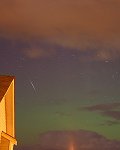
|
Laurence Harry,
Nanaimo British Columbia May. 15 |
#1, #2, #3, #4 |
The sky looked really bright with some of the Aurora moving gently accross the sky, I took these pictures using a canon digital rebel with an 18/55mm lens, exposure varying between 15 and 50 seconds F/3.5, ISO 800 |
|
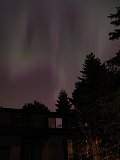
|
Aaron Albert,
Toronto, Ontario, Canada May. 15 |
#1, #2 |
The clouds cleared away just in time for the best auroral display I've ever seen from inside the big city. Plenty bright enough to shine through all the light pollution These photos were taken with a Nikon Coolpix 880, ASA 400, 8s exposure. Photos are very close to what I actually saw. |
| more images:
from Nathan Long of Casper,
Wyoming, USA; from Felix Leung
of Toronto,Ontario,Canada; from Joe Ellenbecker of Milwaukee, Wisconsin,
USA; from Paul L Meisel of
Ward County, North Dakota; from
Peter Boytang at the Space Hut Observatory near Edmonton Alberta;
from Ray Majoran at Three
Mile Lake, Muskoka Lakes, Ontario; |

